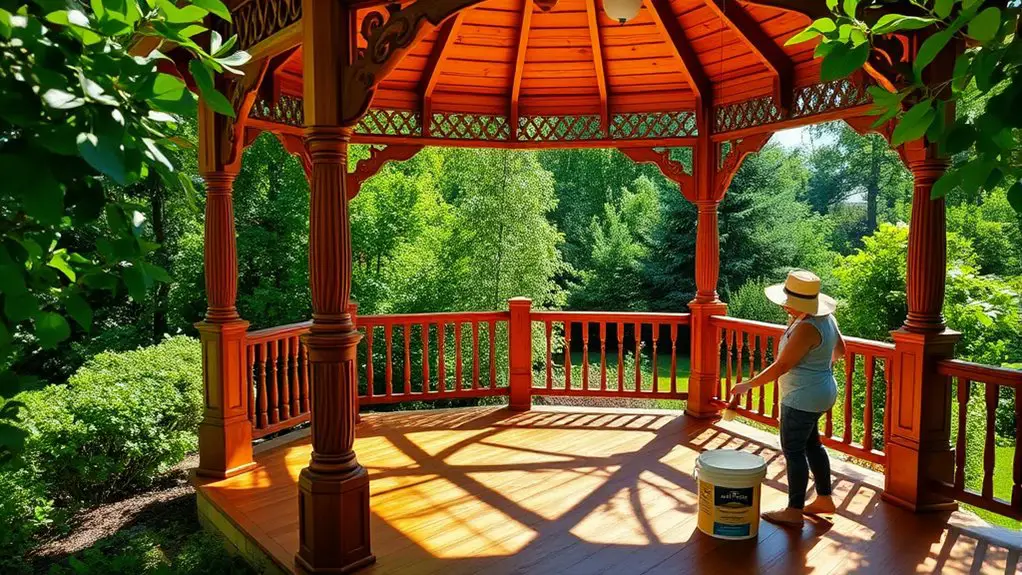To maintain your wooden gazebo, start with regular inspections for signs of wear, such as cracks or insect damage. Clean it with a gentle wood cleaner and protect against moisture by installing barriers and ensuring proper drainage. Apply the right finish, choosing between oil-based for durability or water-based for ease. Keep pests at bay by sealing openings and checking for infestations. For damaged areas, use wood filler and reinforce structure as needed. Explore further for more detailed maintenance techniques.
Inspecting Your Gazebo Regularly
Inspecting your gazebo regularly is essential for its longevity and structural integrity. During these gazebo inspections, you’ll want to check for any signs of wear, such as cracks, warping, or insect damage. Start by examining the roof; verify shingles are intact and free of debris. Then, turn your attention to the posts and beams, looking for any signs of rot or instability. Pay close attention to joints, where most stress occurs; loose hardware can compromise your structure.
Regular check-ups should also include evaluating the foundation to prevent settling issues. Don’t forget to inspect the flooring; loose boards can pose safety hazards. A simple checklist can help guide you through each inspection, making sure nothing gets overlooked. By maintaining a routine, you empower yourself to enjoy your gazebo freely, knowing it’s safe and sound for gatherings or relaxation. Additionally, regular inspections help identify issues like loose parts or unstable structures, ensuring safety.
Cleaning Your Wooden Gazebo
After verifying your gazebo’s structural integrity through regular inspections, the next step is to keep it clean. Start by choosing the right wood cleaner options; a gentle, biodegradable cleaner is ideal for preserving the wood’s natural beauty without harsh chemicals. You’ll need some essential cleaning tools: a soft-bristle brush, a bucket, and a garden hose or pressure washer with a low setting.
Begin by sweeping away debris like leaves and dirt to prevent buildup. Mix your chosen cleaner with water according to the product’s instructions in your bucket. Dip the brush into the solution and scrub the wood, paying special attention to crevices and joints where dirt can accumulate. Rinse thoroughly with water to verify no cleaner residue remains, as this could harm the wood. Regular cleaning not only enhances your gazebo’s appearance but also extends its lifespan, allowing you to enjoy your outdoor sanctuary to the fullest. To further protect your gazebo, consider using mould-resistant sprays after cleaning to prevent future growth and ensure a safe environment.
Protecting Against Moisture Damage
To protect your wooden gazebo from moisture damage, it’s vital to implement preventive measures that maintain its structural integrity. Start by installing moisture barriers around the base; these materials will effectively shield the wood from ground moisture. Consider using a vapor barrier under your gazebo to restrict moisture rising from the soil.
Next, focus on drainage solutions. Verify that the area surrounding your gazebo slopes away to direct rainwater away from the structure. If your gazebo has a roof, clean and clear gutters regularly to avoid water pooling. You might also want to install downspouts that channel water far from the foundation.
Finally, inspect for signs of water damage, like swelling or discoloration. Addressing these issues early can prevent more significant problems down the line. By taking these steps, you’ll preserve the beauty and longevity of your gazebo, allowing you to enjoy it for years to come. Additionally, regular maintenance, such as sealing and staining, is essential to protect the wood from the elements and maintain its durability.
Applying the Right Finish
When it comes to applying the right finish to your wooden gazebo, selecting a suitable wood finish is essential for longevity and protection. You’ll want to take into account various options, such as stains, sealants, and paints, each offering unique benefits. Mastering proper application techniques will guarantee an even coat and enhance the wood’s natural beauty, so let’s explore the best methods and tips for achieving a flawless finish. Additionally, choosing a finish that provides weather resistance will help ensure the gazebo withstands environmental elements effectively.
Choosing Suitable Wood Finish
How can you guarantee your wooden gazebo stands the test of time? Choosing the right wood finish is essential. Oil-based finishes, for example, offer excellent durability and resistance to moisture, making them ideal for outdoor settings. They penetrate deep into the wood, enhancing its natural beauty while providing long-lasting protection against the elements. However, they can take longer to dry and may emit strong odors.
On the other hand, water-based finishes dry quickly and are low in volatile organic compounds (VOCs), making them a healthier choice for you and the environment. They’re easier to apply and clean up, but might require more frequent reapplication. Consider your lifestyle and preferences to find the perfect balance between protection and aesthetics for your gazebo.
Application Techniques and Tips
Applying a finish to your wooden gazebo can seem challenging, but with the right techniques, it can yield stunning results. Start by selecting quality application tools—brushes, rollers, or sprayers work best depending on your finish type. For staining techniques, opt for a brush to guarantee thorough penetration into the wood grain; this enhances durability. Apply the finish in sections, going with the wood grain to avoid streaks. Remember to maintain a wet edge to prevent lap marks. If using a sprayer, practice on a scrap piece first to control flow and avoid overspray. Finally, allow adequate drying time between coats, which not only protects but also enhances the gazebo’s natural beauty. Enjoy your outdoor space!
Treating for Pests
Although pests might seem like a minor inconvenience, they can cause significant damage to your wooden gazebo if left unchecked. Start with pest identification—look for signs like frass, wood shavings, or visible insects. Common culprits include termites and carpenter bees, both of which can compromise your gazebo’s structural integrity.
Once you’ve identified the pests, explore treatment options. Chemical treatments, such as insecticides, can effectively eliminate infestations but should be used cautiously to avoid harming the environment. Alternatively, consider natural remedies, like neem oil or diatomaceous earth, which deter pests without harsh chemicals. Regular inspections and preventative measures, such as applying protective sealants, can help keep pests at bay. Additionally, be mindful of common issues such as overhanging branches or stagnant water that can attract unwanted visitors. By staying vigilant and proactive, you can enjoy your gazebo free from pest-related worries.
Repairing Damaged Areas
When it comes to repairing damaged areas of your wooden gazebo, you first need to identify the types of damage—be it rot, insect infestation, or physical wear. Understanding the appropriate repair techniques for each issue will guarantee a lasting fix, while implementing preventative maintenance can help you avoid these problems in the future. Additionally, regular cleaning and rust prevention methods can help prolong the life of your gazebo and maintain its appearance. Let’s explore these essential steps for keeping your gazebo in top shape.
Identify Damage Types
As you assess your wooden gazebo, it’s essential to recognize the various types of damage that can compromise its integrity. Start by looking for signs of cracking wood, which often occurs due to fluctuations in moisture levels. These cracks can expand if not addressed, leading to structural weaknesses. Next, check for wood discoloration, a clear indicator of rot or mold, often resulting from prolonged exposure to moisture. Discoloration can signal deeper issues beneath the surface that require your attention. Be vigilant for insect infestations, which can undermine the stability of your structure. By identifying these damage types early, you can guarantee your gazebo remains a refuge of freedom and enjoyment for years to come.
Repair Techniques Overview
Once you’ve identified the types of damage affecting your wooden gazebo, the next step is to implement effective repair techniques to restore its integrity. For minor cracks or splintering, epoxy or wood filler works well as repair materials, ensuring a smooth, durable finish. When replacing rotting wood, choose rot-resistant lumber and use a saw for precise cuts. Your tool selection is essential; a power drill and screwdriver will expedite the process, while sandpaper will help blend repairs seamlessly. If structural elements are compromised, consider employing braces for added support. Always prioritize safety by wearing gloves and goggles during repairs. By following these techniques, you’ll not only enhance your gazebo’s appearance but also prolong its lifespan.
Preventative Maintenance Tips
To guarantee your wooden gazebo remains in prime condition, you’ll want to adopt a proactive approach to maintenance that focuses on repairing damaged areas before they escalate into larger issues. Start by inspecting your gazebo regularly as part of your maintenance schedule; look for signs of rot, cracks, or loose joints. Employ preventative techniques like sealing and staining to protect against moisture and UV damage. If you spot any damage, address it immediately—use wood filler for small cracks and replace any severely compromised boards. Don’t forget to check the hardware; rusting screws can weaken structural integrity. By staying ahead of repairs, you’ll assure your gazebo not only looks great but also provides you with a welcoming space for years to come.
Seasonal Maintenance Tips
While the changing seasons can bring beauty to your outdoor space, they also require you to be proactive in maintaining your wooden gazebo. Staying ahead of seasonal wear not only preserves its charm but extends its lifespan. Here are some essential seasonal maintenance tips:
- Spring Maintenance: After winter, inspect for damage. Clean the roof and apply a fresh coat of sealant to protect against moisture.
- Summer Checks: Regularly clear debris and check for pests. Sweep the floors to keep it inviting for gatherings.
- Fall Preparation: Before leaves pile up, clean gutters and inspect wood for signs of rot. Cover furniture to protect it from moisture.
- Winter Preparation: Guarantee proper drainage around the gazebo. Consider weatherproofing measures like wrapping vulnerable areas to guard against snow and ice. Additionally, ensure that the gazebo is anchored securely to withstand winter storms and high winds.
Frequently Asked Questions
How Often Should I Inspect My Gazebo for Damage?
You should inspect your gazebo more often than a hawk spots its prey! Aim for quarterly checks to catch seasonal damage signs. This gazebo inspection frequency guarantees your outdoor haven stays sturdy and ready for relaxation.
What Type of Wood Is Best for a Gazebo?
When choosing wood for your gazebo, cedar’s advantages include natural resistance to rot and insects, making it durable. Alternatively, pressure-treated wood offers affordability and longevity, though it may require more maintenance over time. Choose wisely!
Can I Paint My Wooden Gazebo Instead of Staining It?
While painting your gazebo opens a vibrant palette of color options, it often lacks the paint durability needed for outdoor conditions. Staining, however, can enhance the wood’s natural beauty while providing necessary protection from the elements.
How Do I Know if My Gazebo Needs Repairs?
You’ll know your gazebo needs repairs by spotting signs of damage, like cracks or rot. Employ repair techniques such as replacing damaged boards or reinforcing joints to guarantee its longevity and maintain that freedom of outdoor enjoyment.
What’S the Best Time of Year for Maintenance?
Spring’s splendid cleaning is perfect for prepping your gazebo, while autumn’s attentive checks guarantee its structural strength. By scheduling seasonal inspections, you’ll preserve its beauty and bolster its durability for delightful outdoor adventures.

